I really thought this would be the year that I sent my monthly updates religiously, but in mid-February I was shocked to receive a second grant for my novel from the Canada Council for the Arts (my humble thanks to all involved!) which means I can actually do all the things I’d been wishing I could do to properly research the setting of my novel’s final leg — a sailing adventure along the St. Lawrence River. So forsaking most other duties, I dove hard into planning mode at the end of February, and took a trip to Gananoque and Wolfe Island at the top of March where I walked along the river and wrote and frankly froze my ass off. The river was mostly frozen, too, but a machine called a bubbler keeps a pathway open for the Wolfe Island ferry and the ice looked so cool as the boat plowed through!
I made some new friends at the Toronto Boat Show back in January, and in March one of them very kindly invited me to a marina in Mississauga. He showed me around a sailboat that he thought would work well for my novel as I had described it to him. Indeed, the boat was exactly what I’d pictured, and it was so helpful to see it in real life and have a specific model to read up on and learn about. I also definitely got vertigo walking around the deck so high above the concrete, and I am already low-key dreading the actual sailing lesson in the Toronto Harbour that I have booked for May. I am not a sporty gal, man. But I shall be brave for my art!
Finally, I’m almost done planning my triumphant return to the whales of Northern Quebec, happening in June. I absolutely cannot wait.
Writing
Let me tell you up front: I’m getting real into the novel-process weeds this month. If you couldn’t give a shit about that type of thing, feel free to skip. But I’ve been meaning to tell you about puddling and the press-down for at least a year now, and the goddamn time has come!
When last I updated on the progress of my book, I’d just begun wrestling with the book’s final act. I’m still there, puddling my way through the third-to-last beat. To shout it out for the zillionth time, I’m following the model proposed by Heidi Reimer’s three-month first draft coaching program, which breaks the novel down into twelve beats (beats are basically sections of a book wherein the protagonist goes through some kind of external or internal shift). I started the program right around this time three years ago, and while I didn’t generate a polished manuscript in three months (Reimer doesn’t suggest that you can), I did end up with a well-developed outline, a big sheaf of complete scenes — some of them not half bad! — and an organized way to approach the next draft, all of which has served me extremely well.
To set myself up to write this current draft, which I call draft 1.5, I went through what I’d produced in my time with Heidi and made notes on what plot points and scenes were missing (a lot!); added headings where I felt the beats roughly started; and re-ordered things a bit. Once I’d done that, I started working through the draft from the top, two beats at a time, making sure the two beats at hand are clean, coherent prose before moving on to the next two. Moving through it in this way means that when it’s done, the draft will have the look, feel, and readability of an actual novel. (Wow, it made me nervous to type that; I immediately wanted to delete it or hedge in some way in case it’s not true, in case I fail again as I have failed before, but you know what? Draft 1.5 is more than two thirds done, and I can see it will be true! Whether it’ll be a good novel or not remains in limbo, but it will be a novel, so I’m leaving it in!)
Maybe you’re wondering, “When you say you’re ‘working through’ these beats, what exactly do you mean? What are the steps that take the draft from scraps and notes to coherent prose?” And maybe you’re not! But it’s something I always wonder about other writers and am infinitely curious about, so I thought I’d share some of what it looks like for me. To be clear, I am not sharing this stuff so as to say “This is how you do it! Follow my process to the letter for best results!” If you’re struggling, please don’t glom onto any of what follows as a lifeline if it doesn’t give you life! I made that mistake with so many prescriptive craft books in my youth and it mostly just slowed me down. I firmly believe there are as many ways to functionally write as there are writers. To my mind the whole thing is about having a good look at what’s already working in your process — no matter how weird or slow or inefficient it may be — and leaning all the way in.
What is puddling?
I call the part of my process I’m about to describe “puddling,” inspired by an artist named Jacky Sawatsky who I met at my beloved Gibraltar Point Centre for the Arts many, many years ago. Jacky, a multi-disciplinary artist several years my senior, was often at the Centre working on a film when I stayed there in my twenties. When someone asked her how her day’s work was going in the communal kitchen, Jacky would often say in her thoughtful way, “Good. Just…puddling at the moment. But good.” When she said “puddling” she would do a light little motion with both hands that gestured toward putting together something intricate and complex. I somehow intuitively knew what she meant, and I really liked both the way she seemed to value this sort of smaller, thinky work and how she’d named it.
And yet, in those days I could not bring myself to name or value my own type of puddling. I truly abhorred any writing session that didn’t yield cold, hard, polished prose and lots of it. Sentences! Paragraphs! Word count! How could I quantify the kind of scrolling and note-making that seemed to occupy so much of my time? Why was I doing that anyway? Surely I was just procrastinating, or otherwise fucking up. I left every session of what I now think of as puddling feeling depressed and angry with myself.
I don’t quite remember when this happened, but I do have a memory of the first time I truly, fully gave myself permission to think of this part of the process as necessary. To acknowledge that doing it was, in fact, how I got the thing done. Rather than spend the entire time I’d devoted to writing that day wondering when I’d pull it together and actually work, I forced myself into framing the hours I spent scrolling and tinkering as valuable. And while I sometimes feel skeptical of the concept of epiphanies, for me this was a genuine one. The reframe, obviously years in the making in my unconscious mind, changed my life. Suddenly this aspect of the work made sense. It was fun, even! Some time later, I hearkened back to Jacky’s lesson and mentally codified this part of my process as “puddling.” The naming helped, too. It’s just part of what I do. When I’m writing scenes in my notebook from scratch, I sometimes still use word count goals to get where I’m going. But puddling sessions are measured by time. And whether what happens during that time feels fully tangible or not, these days I typically emerge with a satisfied feeling of having done the work required to put together something intricate and complex.
Okay, but really what is puddling?
So! When it’s time to start two new beats, here’s what I do: I copy-paste everything I already have of those beats into new documents (one per beat). Sometimes I print up what I have, read it, and annotate further by hand. Sometimes I just start reading and annotating onscreen. As I go through what’s on the page, I start to type new things as they occur to me — both actual prose and notes in all caps on what I might need — no rules! When I stall out on a section or don’t really understand what it’s about, I keep scrolling. It’s just a matter of getting to know what’s there, intuitively putting it in order, and slowly figuring out and adding in what I still need.
I’m also looking for keepers — sentences and paragraphs and sometimes full scenes that already work. Thanks to Heidi’s program’s directives, my first-draft scenes were written by hand in a pretty decent flow state, so they often have at least a little heat and juice to them. When I come upon heat and juice, I try to keep it in and let its content help me further the plot. This is something
talks about often, too. If a sentence seems “good” then whatever content is in it is “true” for the story. So if a juicy sentence I wrote three years ago says that a storm was brewing, I’ll try as best I can to allow the storm to inform the plot so as to respect the juice if you will. Maybe I’ll type up some notes on a storm or, if I’m feeling it, take a stab at a storm scene, either in my notebook by hand, or right in the doc. At this stage, it doesn’t have to be perfect or even great prose, just something banged out to see if it fits. Once I’ve made my notes or banged something out, I’ll usually move on to another part, rather than belabour the storm just now. For me, fresh prose needs to rest, and I’ll come back to it later. So on I scroll.
As things start coalescing more, I start labeling individual scenes and sections using a heading in Google Docs. That way, I can see all the scenes in a neat stack in the Outline Bar at the side and easily jump between them. How I ever wrote long-form without this feature I don’t know, but it has luckily existed for some time. (I’ve tried more novel-specific software like Scrivener, but the learning curve was so steep I quickly gave up and went back to my headings. More isn’t always more imo!)
If I want to get into the nitty-gritty of a specific scene or section, I screen out the noise of the surrounding mess by copying and pasting the section into another doc called the “Pullout” that I always have set up. In the Pullout, I’ll tinker with the smaller section at the sentence level, trying to get it closer to readable and done. When the Pullout session is done, I’ll put the section back in the main doc and let that bit rest while I work through some more.
The other thing I’m doing as I go through the draft is cutting things out that no longer seem to fit. A fear that used to stultify me was that I’d cut the wrong things — I have done so on occasion and kicked myself for days. To mitigate this fear, my working docs (Pullout included) always have three headings at the bottom and thereby the Outline Bar: “Maybe Earlier or Later”; “Other Things”; and “End of Other Things.” When I cut stuff, I just plop it under the right heading — the first for stuff I think I’ll probably use elsewhere; the second for stuff that’s probably gone for good. I use the final heading (“End of Other Things”) to quickly jump to the bottom of the latter collection of scraps so the things I cut are in some kind of order. When I move on to the next two beats, I save all of these leftovers in a separate doc that I’ll scan through when I start the third draft, just to make sure I didn’t accidentally axe some good juice.
Over time, all the above stuff repeats. And repeats. Pulling bits out, putting them back, scrolling through the whole thing, organizing, jettisoning bits under the headings at the bottom as they cease to fit. This is the phase where I largely work out plot problems, too. Sometimes this requires staring at a calendar to figure out what part of the action happened what day, or doing other kinds of outlining work. Sometimes it requires “thinky walks” to shake loose just how or why a character would do the thing I need them to do to serve the story. All of this is part of puddling. All of it is needed, and all of it counts.
If I’m totally honest, there are times when I still hate the whole puddly mess. This part of the process still feels much more vague and less overtly “productive” than amassing a certain word-count, or emerging with a shiny, polished chunk. It’s also hard for me to predict how long the puddling process will take before I’m ready for the next phase — always several weeks per beat, sometimes months, which invariably starts to feel “too long.” But for the most part, I trust myself, and just puddle and puddle away. And time and again — this is how I know it actually works — one glorious day comes when the structure makes sense; I appear to have a handle on all the scenes I actually need; everything’s in roughly the right order; and while lots of coherent prose is still to come, the marching orders are largely there, either roughed in or noted in all caps. Which means it’s time for the Press-down, baby — stay tuned for Part Two!
Writing all this out, I have zero clue if this is boring or helpful or indicates that my brain is extremely fucked or entirely the same as most writers or what. If this kind of thing interests you, or if you do something similar, or nothing like this at all, I’d love to know! And if this is extremely dull to you, I’m sorry. As is typically the case for me, it has felt really good to do the labour of turning something spongy and amorphous into sentences and I’m going to publish Part Two next month, come what may!
Reading
I was on a little Colm Tóibín kick throughout February and March. A friend lent me his latest, Long Island, which was absolutely addictive, and amazing on the prose level, but left me somehow colder emotionally than I’d remembered feeling reading Tóibín in my thirties. So I reread The Blackwater Lightship, and I do think Long Island takes a very different approach than his earlier work. Lightship is absolutely harrowing on the themes of complex families and estrangement and childhood hauntings and death. It moves at a pretty glacial pace replete with endless tea-drinking and confusing conversations. Whereas Long Island is harrowing in a very clear way. The reader feels themselves hurtling toward a cut-and-dried kind of doom, and it almost feels like an exercise in cause and effect, with heterosexual romantic love serving as a simple core to build the plotting acrobatics around. Both are impressive, I enjoyed the read, but I guess I’m ultimately more of a slow-paced confusion type of girl.
After that, I read Nora Webster, which has a recently widowed protagonist, absolutely smashed to bits by grief, who is also being a kind of oblivious bitch to her children and sometimes her sisters and sometimes herself. The limited third person narrator keeps the proceedings somehow both crystal clear and hard to fully parse, and this one’s also pretty slow. Again, the inability for people to communicate with their loved ones effectively was almost more brutal than the more overt depictions of grief.
In all three books, Tóibín does an absolutely masterful job of writing middle-aged and older white women in a way that made me feel both seen and read to absolute filth. Both experiences I enjoyed very much.
As I often do, I listened to interviews with Tóibín discussing the books I’d just finished. What a perfect example of how different writers do it differently, man! Here’s a guy who basically writes the whole thing in his head before he writes it by hand in a notebook, only on one side of the page. So he doesn’t start “the writing” until it’s worked out enough to come out in full paragraphs from the word go. He then goes through and makes edits on the other half of the page — not huge ones, doesn’t sound like — and then it’s typed up and ready to go. My brain, dear leaky sieve that she is, could never, but I find it so fascinating that his can.
Also a while back I read Sofia Samatar’s The Practice, the Horizon, and the Chain and it was totally fucked up and amazing. It’s hauntingly poetic dystopian sci-fi, and it’s the most hilarious and depressing critique of the Sisyphean churn of academic DEI initiatives (in which I’ve been embroiled (largely ineffectually) for many years now) that I’ve ever read. Plus it’s a two-day read, or only one if you’re willing to lose some sleep for a book like I am.
Eating
I have to admit I totally burnt myself out on baking when I tried to bake along with The Great Canadian Baking Show last year, and then went immediately into the Holiday Cookie hole. This year I was thinking I might fully take a break from it until the summer fruit arrives, but then my turn with
’s Sift came up at the library. The book, like her newsletter, is packed with great ideas and Lamb has such an infectious, can-do tone that I simply had to get back on my pie crust and French pastries bullshit. I’ve spent the past couple of weeks doing various veganization experiments that both showed huge promise and colossally failed. More on this in a few months (I know, I’ve been teasing pastry for a minute!), but below is a quick selection of what I’ve been testing these last fevered weeks.Great flaky crust, great cheesy squash galette (sorry for the chunk out of it lol).
VEGAN CANELÉS TWO WAYS, this is not a drill!!! These ones were too squat and pale, others too burnt, but they tasted great, we’re getting there, baby! (You can tell because I splashed out for the proper molds!)
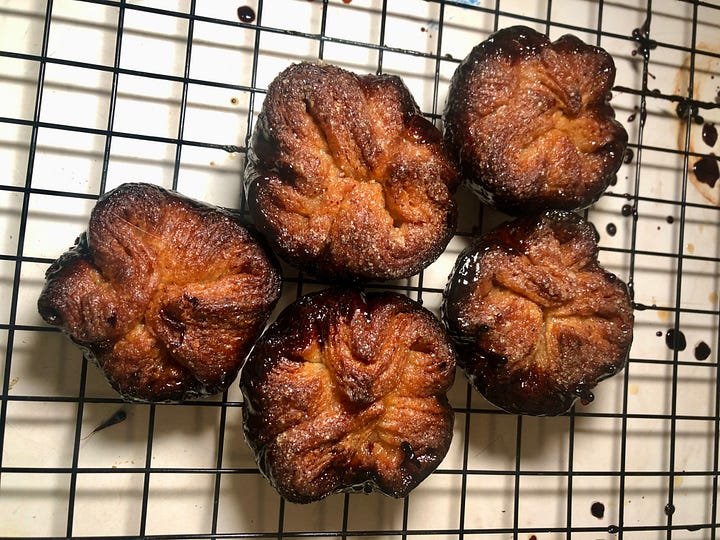

Speaking of burnt, I all but incinerated my first attempt at Kouign-amann, but I learned a ton doing it so I didn’t feel so bad about the waste (they tasted like charcoal).
As per Lamb’s instructions, I used up scraps to make mini-palmiers and I let them get too crunchy, but I loved em all the same.
Finally, baby’s first vol-au-vent?? I can’t say I totally dialled this in, I am hoping to get more height in the future, but it puffed enough to make a little cup which I gleefully stuffed with leftover Thai curry and rice for my breakfast and photographed terribly just for you! That’s it, see you soon! 💚







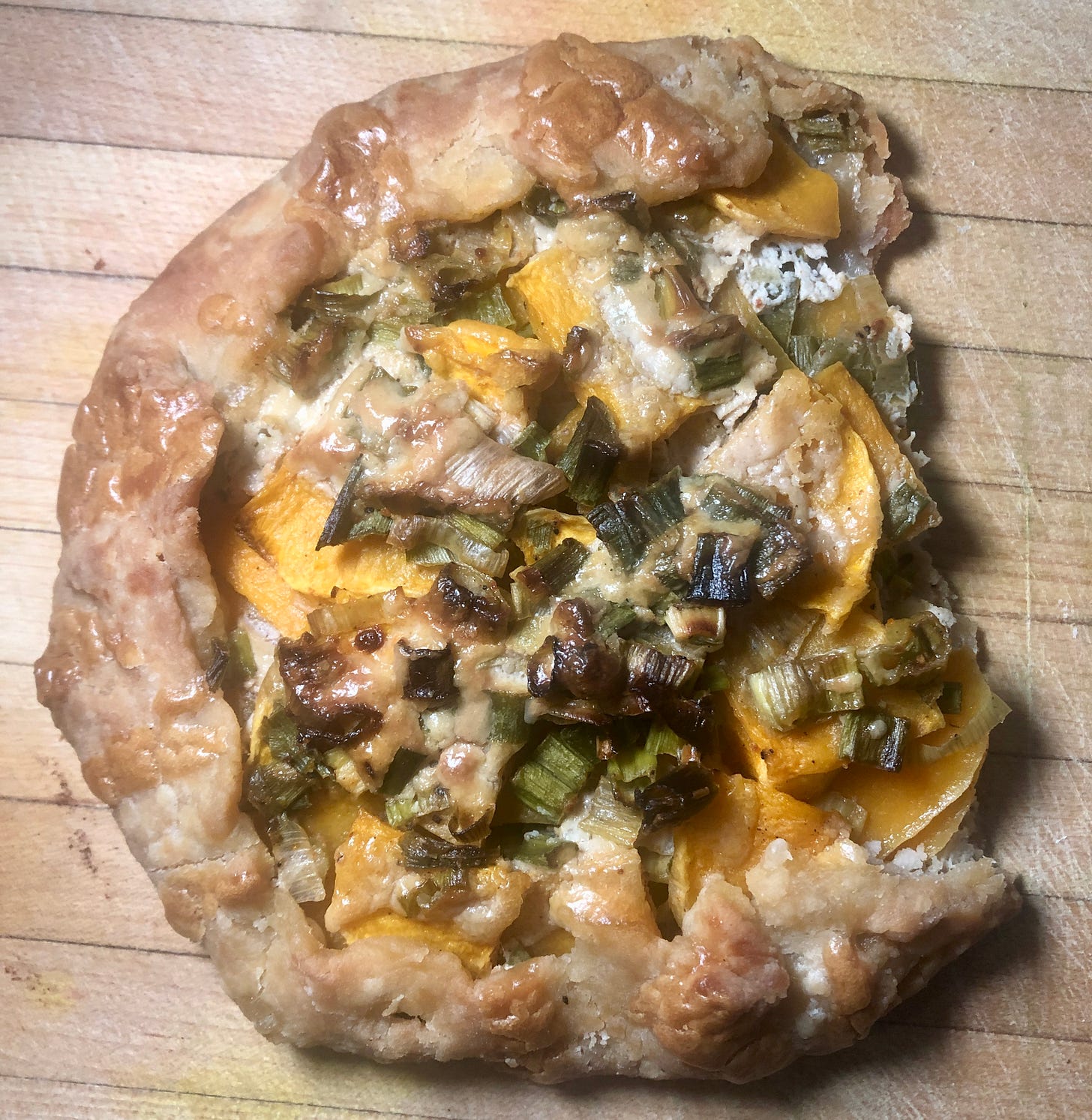
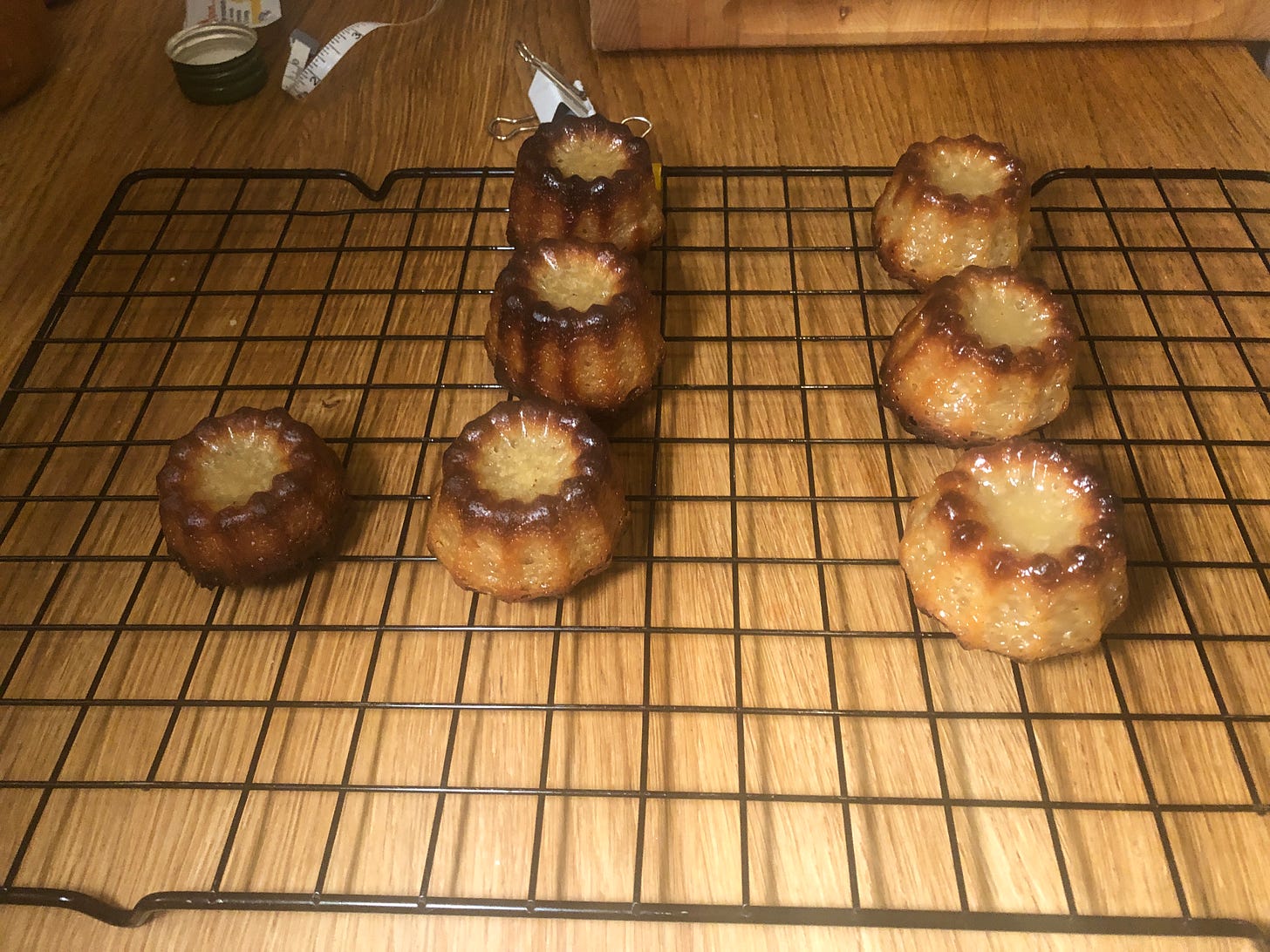
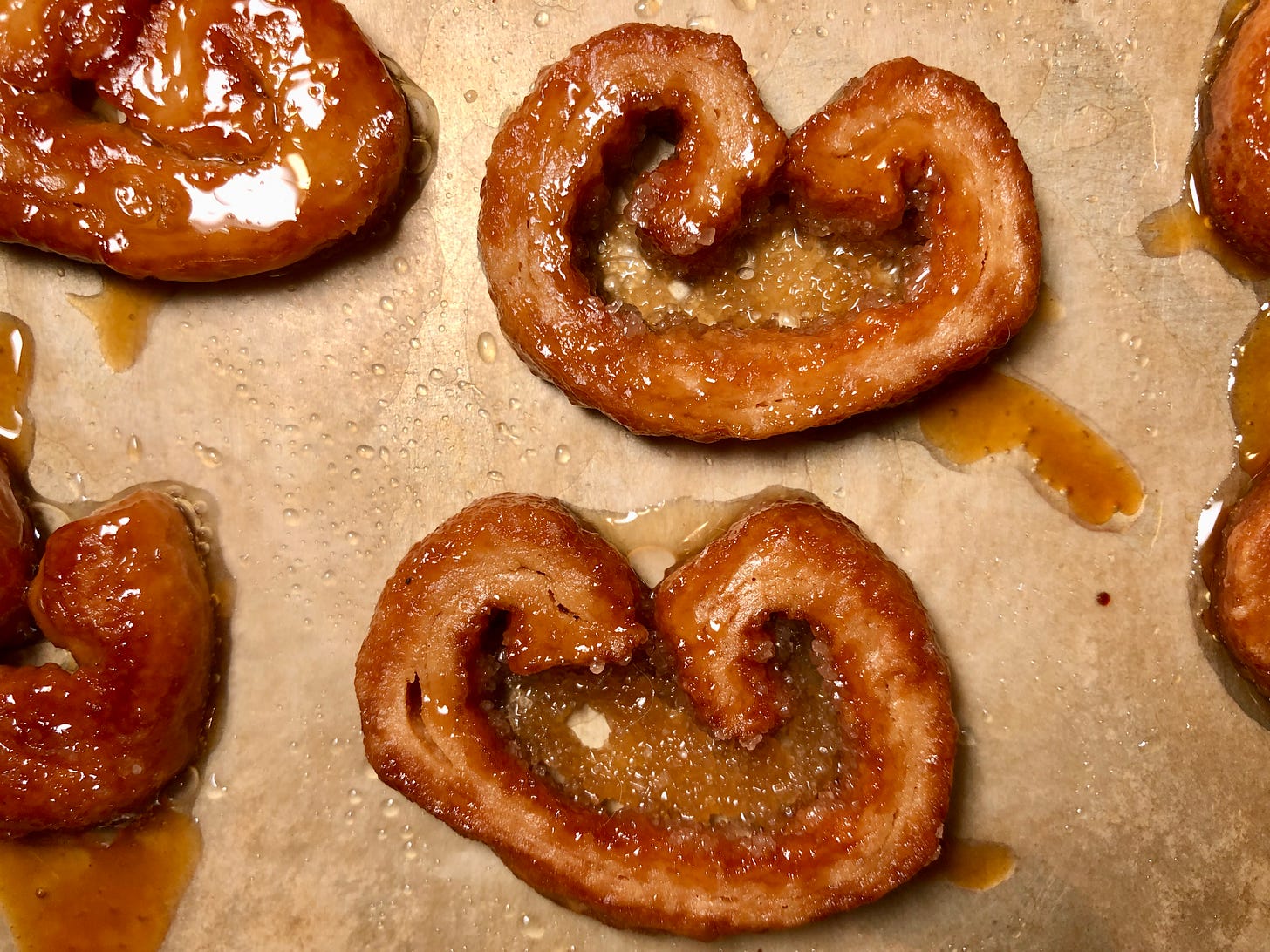
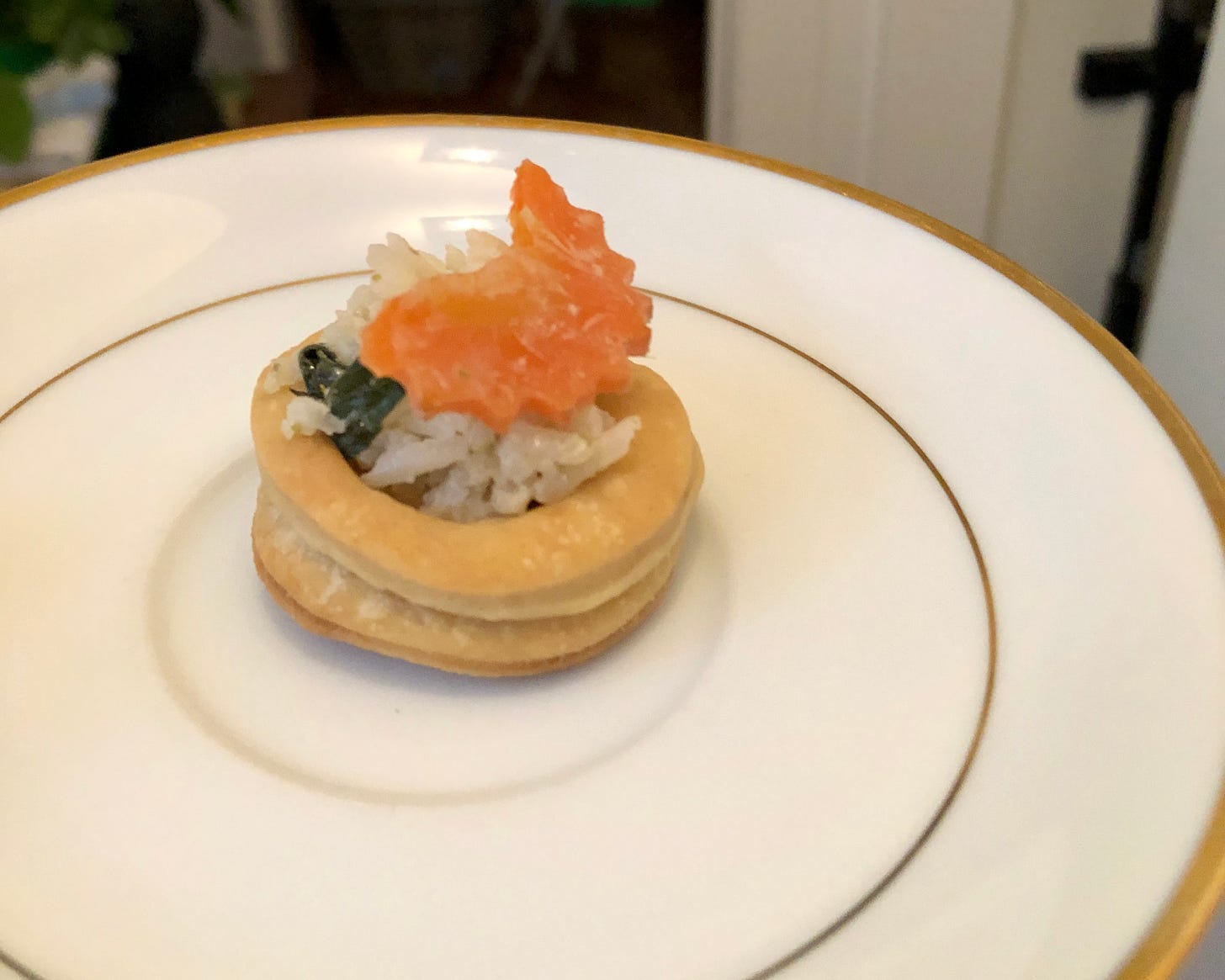
So excited for your novel's progress, but sorry - I might be even more excited for vegan canelés?!
Fascinating